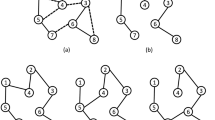Abstract
We give a simple algorithm to find a spanning tree that simultaneously approximates a shortest-path tree and a minimum spanning tree. The algorithm provides a continuous tradeoff: given the two trees and aγ>0, the algorithm returns a spanning tree in which the distance between any vertex and the root of the shortest-path tree is at most 1+√2γ times the shortest-path distance, and yet the total weight of the tree is at most 1+√2/γ times the weight of a minimum spanning tree. Our algorithm runs in linear time and obtains the best-possible tradeoff. It can be implemented on a CREW PRAM to run a logarithmic time using one processor per vertex.
Similar content being viewed by others
References
I. Althöfer, G. Das, D. Dobkin, D. Joseph, and J. Soares, On sparse spanners of weighted graphs,Discrete and Computational Geometry,9(1) (1993), 81–100.
B. Awerbuch, A. Baratz, and D. Peleg, Cost-sensitive anlaysis of communication protocols,Proc. 9th Symp. on Principles of Distributed Computing, 1990, pp. 177–187.
B. Awerbuch, A. Baratz, and D. Peleg, Efficient broadcast and light-weight spanners, Manuscript (1991).
K. Bharath-Kumar and J. M. Jaffe, Routing to multiple destinations in computer networks,IEEE Transactions on Communications,31(3) (1983), 343–351.
B. Chandra, G. Das, G. Narasimhan, and J. Soares, New sparseness results on graph spanners,Proc. 8th Symp. on Conputational Geometry, 1992, pp. 192–201.
L. P. Chew, There are planar graphs almost as good as the complete graph,Journal of Computer and System Sciences,39(2) (1989), 205–219.
J. Cong, A. B. Kahng, G. Robins, M. Sarrafzadeh, and C. K. Wong, Performance-driven global routing for cell based IC's,Proc. IEEE Internat. Conf. on Computer Design, 1991, pp. 170–173.
J. Cong, A. B. Kahng, G. Robins, M. Sarrafzadeh, and C. K. Wong, Provably good performance-driven global routing,IEEE Transactions on CAD, (1992), 739–752.
J. Cong, A. B. Kahng, G. Robins, M. Sarrafzadeh, and C. K. Wong, Provably good algorithms for performance-driven global routing,Proc. IEEE Internat. Symp. on Circuits and Systems, San Diego, 1992, pp. 2240–2243.
T. H. Cormen, C. E. Leiserson, and R. L. Rivest,Introduction to Algorithms, MIT Press, Cambridge, MA, 1989.
E. W. Dijkstra, A note on two problems in connexion with graphs,Numerische Mathematik,1 (1959), 269–271.
M. L. Freeman and R. E. Tarjan, Fibonacci heaps and their uses in improved network optimization algorithms,Journal of the ACM,34(3) (1987), 596–615.
H. N. Gabow, Z. Galil, T. Spencer, and R. E. Tarjan, Efficient algorithms for finding minimum spanning trees in undirected and directed graphs,Combinatorica,6(2) (1986), 109–122.
J. JáJáIntroduction to Parallel Algorithms, Addison-Wesley, Reading, MA, 1991.
J. B. Kruskal, On the shortest spanning subtree of a graph and the traveling salesman problem,Proceedings of the American Mathematical Society,7, (1956), pp. 48–50.
C. Levcopoulos and A. Lingas, There are planar graphs almost as good as the complete graphs and almost as cheap as minimum spanning trees,Algorithmica,8(3) (1992), 251–256.
D. Peleg and J. D. Ullman, An optimal synchronizer for the hypercube,Proc. 6th Symp. on Principles of Distributed Computing, 1987, pp. 77–85.
F. P. Preparata and M. I. Shamos,Computational Geometry, Springer-Verlag, New York, 1985.
R. C. Prim, Shortest connection networks and some generalizations,Bell System Technical Journal,36 (1957), 1389–1401.
P. M. Vaidya, A sparse graph almost as good as the complete graph on points inK dimensions,Discrete and Computational Geometry,6 (1991), 369–381.
Author information
Authors and Affiliations
Additional information
Communicated by T. Nishizeki.
Current research supported by NSF Research Initiation Award CCR-9307462. This work was done while this author was supported by NSF Grants CCR-8906949, CCR-9103135, and CCR-9111348.
Part of this work was done while this, author was at the University of Maryland Institute for Advanced Computer Studies (UMIACS) and supported by NSF Grants CCR-8906949 and CCR-9111348.
Rights and permissions
About this article
Cite this article
Khuller, S., Raghavachari, B. & Young, N. Balancing minimum spanning trees and shortest-path trees. Algorithmica 14, 305–321 (1995). https://doi.org/10.1007/BF01294129
Received:
Revised:
Issue Date:
DOI: https://doi.org/10.1007/BF01294129




